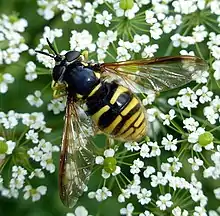Chrysotoxum fasciolatum
Chrysotoxum fasciolatum is a species of holarctic hoverfly. The adults are strong mimics of wasps.[1] Larvae of this genera, when known, are aphid predators.[2]
| Chrysotoxum fasciolatum | |
|---|---|
 | |
| Scientific classification | |
| Domain: | Eukaryota |
| Kingdom: | Animalia |
| Phylum: | Arthropoda |
| Class: | Insecta |
| Order: | Diptera |
| Family: | Syrphidae |
| Subfamily: | Syrphinae |
| Tribe: | Syrphini |
| Genus: | Chrysotoxum |
| Species: | C. fasciolatum |
| Binomial name | |
| Chrysotoxum fasciolatum De Geer, 1776 | |
| Synonyms | |
|
Show list
| |
Distribution
North America, Asia and Europe [3]
Description
For terminology see Speight key to genera and glossary The second antennal joint is longer than broad, and the third joint is two and a half to three times as long as the other two combined. Pteropleura with black pile.The lateral margins of tergites two to five alternating black and yellow, with arcuate abdominal bands interrupted and broader, less arcuate abdominal fasciae, with the front edge of the interrupted fasciae being almost parallel with the anterior margins of the segments. The wing microtrichia is well developed, and the wing vein R4+5 is clearly dipped into cell r4+5. There is no yellow spot above the fore coxa.[4]
References
- Gilbert, Francis (2004). "The evolution of imperfect mimicry in hoverflies". Cambridge University Press: 1–42.
- Shannon, Raymond C (1927). "The Chrysotoxine Syrphid-Flies". Proceedings of the U.S. National Museum. 69: 1–20.
- "Chrysotoxum fasciolatum species information". GBIF. Retrieved 2023-02-17.
- Johnson, Charles Willison (1924). "A review of the New England species of Chrysotoxum". Occasional papers of the Boston Society of Natural History. 5: 97–100.
 This article incorporates text from this source, which is in the public domain.
This article incorporates text from this source, which is in the public domain.